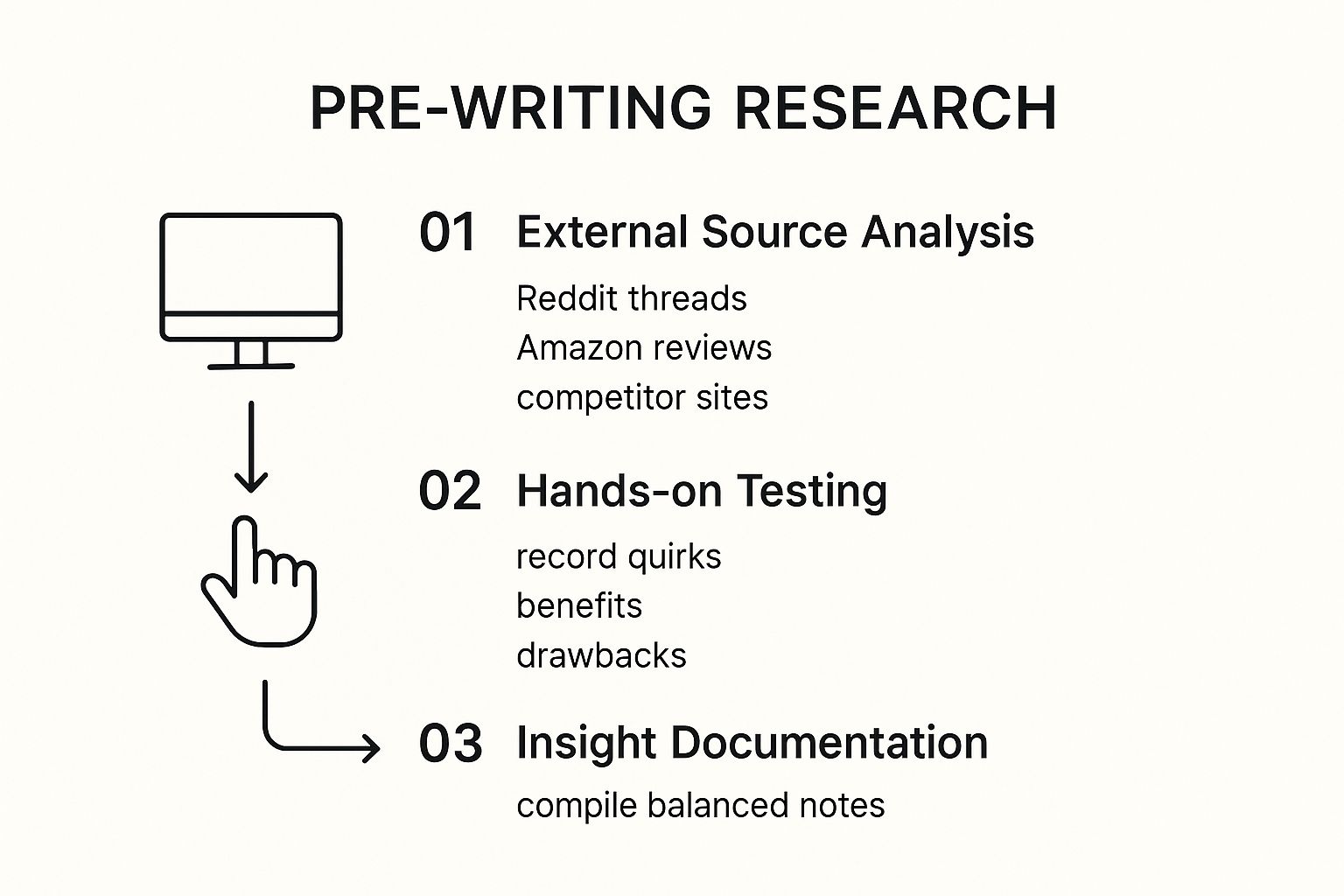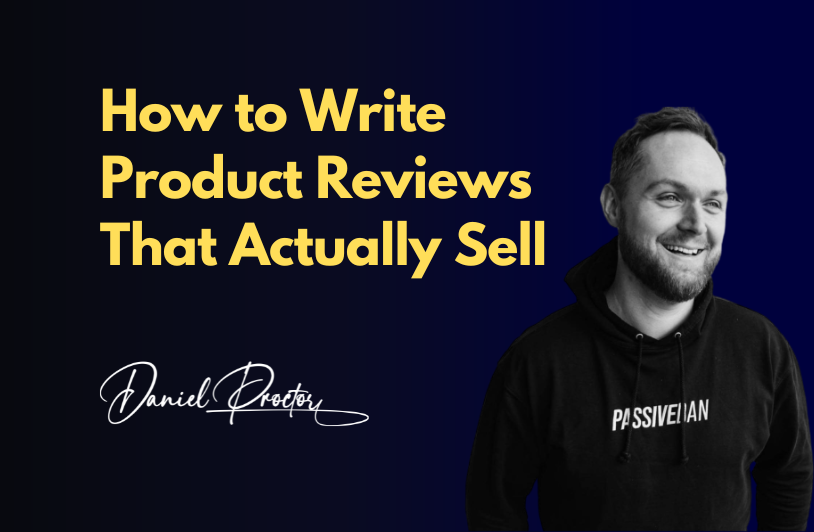Before you even think about a headline, the real work of writing a product review that actually converts begins. The secret isn’t some fancy writing trick; it’s all about one simple, human thing: trust.
In a world flooded with sponsored posts and generic fluff, readers have gotten incredibly good at sniffing out fake reviews. Your goal isn’t just to list features. It’s to become a trusted guide who helps someone make a smart decision. This means shifting your mindset from “selling a product” to “solving a problem.”
Building the Foundation of a Trustworthy Review

Choose Products You Can Genuinely Endorse
Want to kill your credibility fast? Promote something you don’t actually believe in. Readers can sense when you’re faking it. The whole foundation of a good review rests on picking products that you’d genuinely use and that fit your expertise.
Before you agree to review anything, ask yourself:
- Does this product actually help my specific audience?
- Would I spend my own money on this?
- Am I confident enough to recommend it to a friend?
If you hesitate on any of these, just pass. Chasing a quick commission on a garbage product will cost you your audience’s trust, and that’s the most valuable thing you have.
The Non-Negotiable Value of Hands-On Testing
Just rewriting a product’s sales page is a surefire way to get ignored. The real gold comes from getting your hands on the product and using it yourself. This is where you find the little details and insights the manufacturer conveniently leaves out.
A spec sheet tells a reader what a product does. A great review tells them how it feels to use it. It’s the small details—the quirks, the unexpected delights, and the minor frustrations—that build a powerful, relatable narrative.
For instance, a spec sheet might claim a camera has “fast autofocus.” A real, hands-on review can say, “The autofocus was so quick it locked onto my dog sprinting across the yard, something my old camera could never handle.” See the difference? That specific, relatable story is infinitely more powerful.
Finding Your Unique Angle and Voice
Thousands of other affiliates are probably reviewing the same thing. The only way you’ll stand out is with your unique perspective. Don’t just list features; tell a story that connects with a specific person.
- For the busy professional: How does this productivity tool actually save you an hour a day?
- For the budget-conscious parent: Is this toy durable enough to survive a house with three kids?
- For the tech novice: How painful was the setup process for someone who isn’t a tech genius?
This approach makes your review feel less like a manual and more like a chat with a helpful friend. It shows you get them and their problems.
Finally, trust is built on transparency. Being upfront about your affiliate links isn’t just a legal thing—it actually makes you more credible. A simple, clear disclosure shows you’ve got nothing to hide. If you want to see how to do it right, check out these practical affiliate link disclosure examples. This kind of honesty shows your audience that your first priority is helping them.
Your Pre-Writing Research and Testing Playbook
A truly great review is built on a mountain of research and genuine experience. Honestly, before you even think about typing a single word, the most important work happens behind the scenes. This is where you dig past the manufacturer’s shiny sales pitch to find out what the product is really like.
This groundwork is what separates a forgettable, generic review from one that people actually read, trust, and click on. You’re basically becoming a detective for your audience, piecing together the full story from every possible source—especially the most important one: your own hands-on testing.
This infographic breaks down the whole pre-writing process, from snooping around online to getting your hands dirty with the product.

Following these steps ensures your review is detailed, fair, and answers the questions your readers are actually asking.
Digging Deep into Third-Party Sources
Your first stop should be anywhere real people are talking. The manufacturer’s website is fine for specs, but it won’t tell you about that annoying software bug or the surprisingly awesome feature nobody mentions. You need the unfiltered truth.
- Dive into Reddit Threads: Find the subreddits for the product’s niche. A quick search for the product name will often pull up raw, honest frustrations, clever workarounds, and candid praise. This stuff is gold.
- Analyze Amazon Reviews: Skip the 5-star raves for a minute. The real insights are hiding in the 2, 3, and 4-star reviews. That’s where you’ll find balanced feedback on what works, what falls short, and who the product is actually a good fit for.
- Scan Competitor Reviews: See what other affiliates are saying. More importantly, see what they aren’t saying. Did they all gloss over the setup process? Did they miss a key drawback? That gap is your opportunity to write something way more helpful.
Pulling all this research together gives you a hit list of common questions, pain points, and cool features to investigate when you get your hands on the product.
The goal isn’t to just repeat what others are saying. It’s to understand the current conversation so you can add something new and valuable to it—answering the questions other reviews missed.
Documenting Your Hands-On Experience
Alright, this is where the magic happens. Getting the product in your hands is completely non-negotiable for an authentic review. As you use it, you need to be a meticulous note-taker, documenting everything—the good, the bad, and the just plain weird.
Keep a running log or notebook to capture your thoughts as they happen. Don’t wait until the end to try and recall those first impressions. You’re looking for the specific details a spec sheet will never give you.
Here’s a simple framework for your notes:
| What to Document | Why It Matters | Example |
|---|---|---|
| First Impressions | The unboxing and setup are a huge part of the customer journey. | “Packaging felt premium, but the included instructions were a confusing mess.” |
| Unexpected Benefits | These are the pleasant surprises that make people love a product. | “I was shocked the battery lasted a full two days with heavy use.” |
| Frustrations & Quirks | Being honest about flaws builds trust and helps readers decide. | “The main button is so awkwardly placed that I kept hitting it by accident.” |
| Real-World Scenarios | This connects features to actual, tangible results. | “Took it to the beach to test the ‘waterproof’ claim. It got splashed a ton and held up perfectly.” |
This detailed log of your personal experience becomes the backbone of your review. It’s what provides the specific, relatable stories that make your content believable and compelling.
Finding Gaps and Defining Your Angle
Once you’ve done your research and testing, spread out all your notes. Look for a common thread or an overarching theme. What’s the one big story this product is trying to tell?
Maybe it’s a budget option that punches way above its weight. Or maybe it’s a premium product with a fatal flaw that no one else is talking about. Nailing this unique angle is what will make your review stand out in a sea of sameness.
Ask yourself these three questions to find your angle:
- What question did I have that was a pain to find an answer to?
- What awesome (or awful) feature is everyone else overlooking?
- Who is this product really for, and who should absolutely avoid it?
Answering these helps you write a review that doesn’t just list features but delivers a clear, confident verdict. It’s this deep pre-writing work that makes the final article rich with detail, grounded in real experience, and genuinely useful to your reader.
Structuring Your Review for Readability and Impact

Look, even the most mind-blowing review will fall flat if it’s just a giant wall of text. Structure isn’t about making things look pretty. It’s about strategically guiding your reader from their first curious click all the way to your final call-to-action.
A well-organized article respects your reader’s time. It lets them skim for the highlights or dive deep into the nitty-gritty details that actually matter to them. This thoughtful layout is what keeps people on your page and moves them toward making a smart decision.
Hook Them Instantly with a Powerful Introduction
You have maybe three seconds to convince someone to stick around. Your intro needs to immediately tap into the problem they’re trying to solve.
Don’t start with a boring product history lesson or a generic, “In this review, I’ll be reviewing…” It’s a snoozefest.
Instead, open with a relatable scenario. If you’re reviewing a project management tool, try something like, “Ever feel like you’re drowning in a sea of deadlines and scattered tasks?” This instantly validates their frustration and hints that you’ve got a solution, making them keen to read on.
Your intro should also clearly state what product you’re reviewing and who it’s for. This sets the right expectations from the get-go.
The Non-Negotiable Summary Box
Let’s be honest: a huge chunk of your readers are just skimmers. They’re busy people who want the bottom line, and they want it now. A summary box, placed right near the top, is the single best way to serve them and stop them from hitting the back button.
This box is the “too long; didn’t read” (TL;DR) version of your entire article. It needs to give a quick, digestible overview of your final verdict.
Here’s the breakdown of what every great product review needs in a summary box, designed to turn a curious reader into a confident buyer.
| Review Component | Its Purpose and What to Include |
|---|---|
| Overall Rating | A simple star or numerical score (e.g., 4.5/5 stars) gives an immediate impression. |
| Quick Verdict | A one-sentence summary of who the product is perfect for. Be specific. |
| Key Pros | List the top 2-3 standout benefits. What are the absolute best things about it? |
| Key Cons | Mention the 1-2 most important drawbacks. This builds trust and shows honesty. |
| Call-to-Action | A clear, unmissable button that links directly to the product’s sales page. |
This single element provides massive value upfront and acts as a central hub that skimmers will keep coming back to.
Breaking Down the Body Logically
Once you’ve hooked the reader and given them a summary, the body of your review has to deliver the goods. Don’t just dump a random list of features on them. Organize your thoughts into logical sections that walk them through the actual experience of using the product.
A fantastic way to do this is by dedicating subheadings to specific features or real-world use cases. For a camera review, skip the generic “Features” heading. Instead, use descriptive titles like “Image Quality in Low Light” or “How Good is the Autofocus for Action Shots?” This helps readers jump straight to the info they care about most.
Your review’s body should tell a story. Walk the reader through the setup, the daily use, and the specific outcomes. This narrative approach is far more engaging than a dry list of technical specifications.
By framing the body around how the product is actually used, you turn abstract features into tangible benefits. You’re not just showing what the product does, but what it can do for them.
Presenting Pros and Cons Without Bias
A dedicated pros and cons section is another must-have for both scannability and trust. Seeing a balanced list shows you’re offering an honest take, not just a thinly veiled sales pitch. But how you present them matters.
Don’t just list vague points. Give them context. For instance:
- Weak Pro: “Good battery life.”
- Strong Pro: “The battery easily lasted a full 12-hour workday with heavy use, meaning you can leave the charger at home.”
The same goes for the cons:
- Weak Con: “Expensive.”
- Strong Con: “The premium price tag might be a deal-breaker for beginners, but the advanced features justify the cost for professionals.”
This balanced approach proves you’ve thought critically about the product from different angles.
Suggesting Viable Alternatives
This is a pro move that so many affiliates miss. Including a brief section on alternatives is a massive trust signal. It shows your main goal is to help the reader find the best solution for them, even if it’s not the product you’re reviewing.
Pick one or two direct competitors and briefly explain who they might be a better fit for. Something like, “While Product X is perfect for solo entrepreneurs, teams of five or more might find Product Y’s collaborative features a better fit.” This shows you’ve done your homework and solidifies your authority.
Ultimately, a well-structured review is a roadmap that guides your reader from being curious to feeling confident. It’s a vital piece of the puzzle that works hand-in-hand with great content to drive sales, much like how top-tier affiliate marketing landing pages are built to guide a user seamlessly toward one specific action.
Writing with an Authentic Voice That Builds Trust

In a world overflowing with generic, AI-spun content, your real voice is the most powerful tool you have. Anyone can list a product’s specs, but only you can share your actual experience with it. That’s what separates a forgettable review from one that actually connects with a reader and earns their trust.
Think of it this way: your review shouldn’t sound like a corporate brochure. It needs to feel like getting helpful advice from a friend who knows their stuff. This means dropping the stiff, formal language and just writing like you talk.
This connection isn’t just a nice-to-have; it’s critical. An incredible 95% of consumers read online reviews before buying something. And even more telling, 85% of them trust those reviews as much as a personal recommendation. That’s why your authenticity is everything. You can find more stats on consumer review habits on shapo.io.
Find Your Unique Conversational Tone
Finding your voice isn’t about creating a fake persona. It’s about leaning into how you naturally communicate. How would you explain this thing to a friend over coffee? That’s the tone you’re aiming for.
Start by thinking about who you’re talking to. Are they a tech whiz or a complete beginner? Your language needs to match their level of understanding.
- For Beginners: Use simple analogies and skip the technical jargon. Explain concepts like you’re guiding them through it for the very first time.
- For Experts: You can get more technical, but the tone should still feel helpful and collaborative, not like you’re talking down to them.
When you tailor your language like this, your content feels personal and relevant. It shows the reader you actually get where they’re coming from.
Share Real Stories and Detailed Examples
Personal stories are the secret sauce of a great review. They turn a boring list of features into real, tangible benefits. A feature list is just data; a story is an experience.
Instead of just saying, “The backpack has a waterproof compartment,” tell the story: “I got caught in a surprise downpour on a hike, convinced my laptop was toast. When I got back to the car, everything in the main section was soaked, but my MacBook inside that waterproof sleeve was completely bone-dry. That feature alone was worth the money.”
This level of detail does more than just describe a feature—it proves its real-world value. It’s the proof that you’ve actually used the product, building a layer of credibility that a simple list of features never could.
This narrative style is a core skill for any serious content creator. For anyone looking to monetize their blog, we dive deep into this technique in our guide on affiliate marketing for bloggers.
The Surprising Power of Pointing Out Flaws
It feels a little backward, but one of the quickest ways to build trust is to be honest about a product’s downsides. A review that does nothing but sing praises just sounds like a sales pitch. Let’s be real—no product is perfect, and your readers know it.
Being upfront about flaws shows that your loyalty is with your reader, not the brand or the commission check. It proves you’ve done a real, critical evaluation.
When you talk about the negatives, be specific and give context:
- Weak Flaw: “The battery life isn’t great.”
- Strong Flaw: “While the battery gets you through a full day of light use, it drained in just four hours when I was editing video. It’s totally fine for casual tasks, but power users will want to keep a charger nearby.”
This kind of constructive criticism doesn’t just build trust; it actually helps the reader make a smarter choice. They can weigh that specific con against their own needs. Someone who only uses the product for light web browsing might not care about the battery issue, which makes your honest take even more valuable to them.
Optimizing Your Review for Google and Readers
Look, writing a fantastic, in-depth review is only half the battle. If nobody can find it on Google, it might as well not exist. This is where a little search engine optimization (SEO) makes a huge difference, getting your hard work in front of the right eyeballs.
Optimizing your review isn’t about some secret handshake with Google’s algorithm. It’s simply about making your content crystal clear for both search engines and the actual people reading it. The whole point is to line up what you’ve written with the exact stuff people are typing into their search bars.
Uncovering What Your Audience Is Really Searching For
Good SEO starts with getting inside your reader’s head. What questions are they asking? What comparisons are they trying to make? To get your reviews seen, mastering how to find the best keywords for SEO success is a non-negotiable skill.
You have to think beyond just the product’s name. When people are close to pulling out their credit cards, they search in very specific ways.
- Comparison Keywords: Phrases like “Product A vs Product B” are pure gold. Someone searching this is literally in the final moments of making a decision.
- “Best for” Keywords: Think “best noise-canceling headphones for studying” or “best portable blender for small apartments.” These target people with a specific problem that needs solving, right now.
- Question-Based Keywords: Searches like “is Product X worth it?” or “how does Product X work?” show they’re looking for a detailed, honest breakdown.
When you go after these longer, more specific keywords, you attract traffic that’s not just browsing—they’re ready to buy.
Mastering Crucial On-Page SEO Elements
Once you’ve figured out what people are searching for, you need to send clear signals to Google that your page has the answers. This boils down to a few key on-page elements you just can’t skip.
Your title tag (the headline in the search results) and meta description (the little summary underneath) are your first impression. They have to be good enough to earn that click. Always pop your main keyword in the title and write a meta description that tells people exactly why they should read your review over all the others.
Inside the article, use a logical heading structure (H2s and H3s) to break things up. It helps readers scan and also shows search engines the hierarchy of your information. This is a fundamental concept for getting content to perform, something we drill down on in our guides on how to make money with Amazon affiliate marketing.
And please, don’t forget your images. Every single one needs descriptive alt text. Instead of “image1.jpg,” describe what’s in it, like “close-up of the product’s intuitive user interface.” This helps you rank in image search and makes your site more accessible.
Think of on-page SEO as a set of clear signposts. Each element—your title, headings, and alt text—guides Google and your readers through your content, confirming that you have the detailed, relevant information they’re searching for.
Earning Star Ratings in Search Results with Schema
Ever see those eye-catching star ratings right there in the Google search results? That’s not some kind of magic trick. It’s the result of using structured data, specifically review schema.
Schema markup is just a little snippet of code you add to your page that flat-out tells Google, “Hey, this is a product review.” It lets you specify details like the product’s name, your rating, and who wrote the review.
Getting those stars to show up can seriously boost how many people click on your link. A result with five bright yellow stars just stands out more than a plain text one next to it. And while it sounds technical, plenty of WordPress plugins can handle this for you with just a few clicks. It’s an easy win.
A Few Common Questions I Get Asked
Even when you’ve got a solid framework, some questions always seem to pop up right when you’re ready to start writing. Let’s tackle a few of the most common ones I hear from other reviewers.
How Long Should My Product Review Be?
This is the classic “how long is a piece of string?” question. There’s no single magic number, but if you look at the reviews ranking on the first page of Google, you’ll see most of them land somewhere between 1,500 and 3,000 words.
But honestly, obsessing over a word count is the wrong way to think about it.
A simple product might only need 1,000 words. A deep dive into a complex software tool could easily push past 4,000 words to feel complete. The real goal is to be thorough. Answer every question a reader could possibly have before they even think to ask it.
Your review is long enough when it’s genuinely helpful. It’s done when you’ve covered the key features, shared your real-world take, talked about the good and the bad, and given the reader enough information to make a confident decision.
Can I Review a Product I Haven’t Actually Bought?
You can, but I wouldn’t recommend it. It’s a risky move that can absolutely torch your credibility.
When you just pull information from spec sheets or other people’s opinions, you end up with generic, soulless content. It’s missing the little details—the quirks, the frustrations, the unexpected wins—that only come from actually using the thing.
Readers have a built-in radar for this stuff; they can spot a fake a mile away. If you absolutely can’t get your hands on the product, you have to be completely transparent. Call it a “brand comparison” or a “research summary” based on public info and customer feedback. Authenticity is everything.
What Do I Do About All the Negative Reviews I See?
You use them. In fact, they can be your secret weapon. When you’re doing your research on places like Reddit or Amazon and see the same complaints over and over, don’t just ignore them. Address them head-on in your review.
This is your chance to really shine.
- Try to replicate the problem: Can you make the same issue happen? Is it a genuine design flaw, or is it just user error?
- Offer a fix: If the problem is real, is there a simple workaround? Maybe a setting that needs to be changed or an accessory that helps?
- Validate or debunk it: Use your hands-on experience to either say, “Yep, this is a real issue,” or, “I see why people say that, but here’s why it wasn’t a problem for me.”
Tackling common criticisms head-on shows you’ve done your homework. It provides massive value to readers who have seen those same bad reviews and are looking for a straight answer. It’s a powerful way to build trust and write reviews that are truly a cut above the rest.
Ready to stop guessing and start building a profitable affiliate business? The Daniel Proctor mentorship program gives you the step-by-step playbooks, 1-on-1 coaching, and accountability you need to succeed. Start your journey with our free masterclass today!

